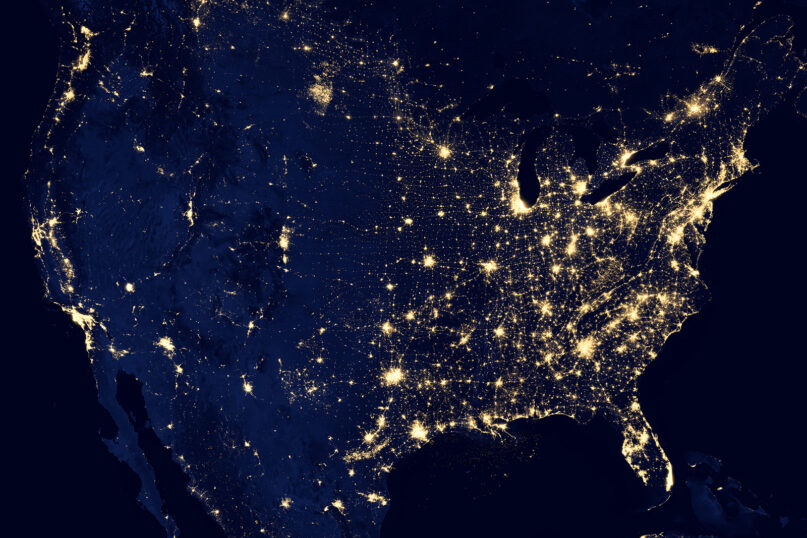(RNS) — On a Sunday morning in early April 22 years ago, I sat among the faithful at a Baptist church in Atlanta, listening to the preacher’s sermon. I had never before been inside a Baptist church, let alone sat through a service. As the preacher finished, he asked everyone to bow their heads, and as one the large crowd obliged.
Except for me. With my head awkwardly up, I quietly scanned the large room, watching in awe at this ever so sacred ritual of piety. While fascinated by this display of communal devotion, I was also uncomfortably aware of being an outsider.
In recent days, there has been much talk of national unity. In his inaugural address, President Joe Biden said, “This is our historic moment of crisis and challenge, and unity is the path forward.”
In the wake of the events that took place two weeks before at the Capitol, calls for unity sound at best like Pollyanna, at worst impossible. Biden acknowledged this point himself, saying that unity seems like a “foolish fantasy.”
Unity is not easy, nor is it the feel-good utopian ideal that we believe it to be. Unity is deeply uncomfortable.
However, it is in this place of discomfort that we can find a path to a workable and sustainable unity in the name of our nation and its future. It is not impossible; I’ve seen it.
Growing up in urban New Jersey, I was raised in a secular and, as I like to say, “Jew-ish” household. I was surrounded by a multifaith citizenry that held little back. My friends and neighbors were Catholic, Muslim, Eastern Orthodox, Buddhist, Jewish, pagan and atheist, and more. We knew when it was Ramadan and Yom Kippur. We knew the smells of traditional holiday foods and recognized the religious home décor, from altars to mezuzahs. That is just the way it was.
In 2015, I attended the sixth Parliament of the World’s Religions, a four-day event held that year in Salt Lake City. Stepping into the Salt Palace Convention Center, I felt like I was home again, surrounded by the world’s cultures in a peaceful, reciprocal sharing of ideas and practice. There amid a sea of difference, thousands of attendees were willing to allow their discomfort to transform into curiosity.
Both my childhood experience and the Utah event are types of unity in practice, one by chance and one for purpose, and both grounded in diversity and immersive exposure.
In that communal space, the discomfort of witnessing can transform fear into peaceful respect between people of different faiths, as well as those of no faith. The discomfort of witnessing can also be, as seen in Salt Lake City, a breeding ground for curiosity with an aim not to convert but to educate.
While at the Parliament, I spent several hours in the Hindu temple, speaking with its keepers, watching dance performances and observing a prayer ritual. I was immersed not only in conversation about religious tenets and ethics, but also in a living culture. Religion is more than its règles de jeu.
The discomfort of exposure and an unwillingness to witness, on the other hand, can backfire, giving rise to righteous anger, distrust and violence. This is what we saw on Jan. 6, when religious rhetoric and symbols accompanied terrorists as they stormed the Capitol.
I have seen my share of such bigotry. Just recently, swastikas were etched into fences in my neighborhood. Sometimes, bigotry can be gentle: Twenty-two years ago, the invitation to attend that Atlanta Baptist church was an attempt to convert me. I have since drawn boundaries with the family members who had thought to subject me to conversion.
In a 2011 sermon, the Rev. Nadia Bolz-Weber discussed a radical type of forgiveness. She suggests that “forgiveness is actually the opposite of saying that what someone has done is okay … It’s saying it’s so not okay that I am not going to absorb it anymore. I simply won’t be tied to it.”
Just as Bolz-Weber has defined a concept of forgiveness that allows for a cutting of cords, unity can be redefined to permit the drawing of boundaries between ourselves and those who seek to destroy our communal bonds and agreements.
Unity is not easy, and it is not permanent. Like democracy, it requires vigilance.
Some have said that the spaces that divide us — among them our religious differences — are far too wide and deep to maintain a workable national unity.
But what is the alternative? Do we have a choice?
I also would argue that the above statement is untrue. The spaces have not grown wider or deeper. We just seem to be increasingly unwilling to build bridges across those deep chasms and to venture beyond our comfort zones.
Some people fear that in building unity we must sacrifice our individuality. That is also not true. My childhood community was unified in its protection of our daily life despite the vast cultural differences that lay behind our front doors.
In fact, unity works best when it builds on cultural diversity, not erasure.
To go forward in this way, we must build those bridges and be willing to, even briefly, experience discomfort, allowing it transform at the very least into peaceful respect, if nothing more.
Biden expressed this concept when he used the common phrase: “stand in another person’s shoes.” That is why I went to the Baptist church that day.
The question before us is not really whether we can achieve and sustain national unity, politically and socially. It is whether we are willing to do the work. It is difficult, but it is possible.
(Heather Greene is a freelance writer and editor and is author of the book “Bell, Book and Camera: A Critical History of Witches in American Film and Television.” The views expressed in this commentary do not necessarily reflect those of Religion News Service.)





